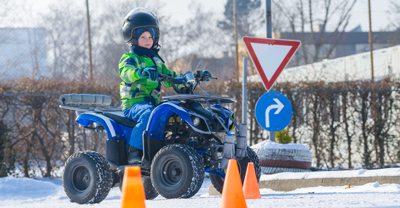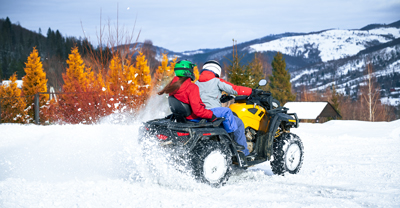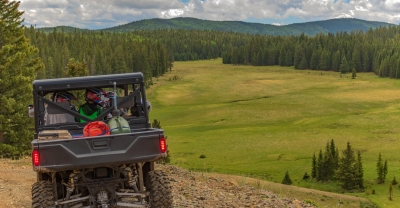ATV safety tips: 10 ways to ride with more control
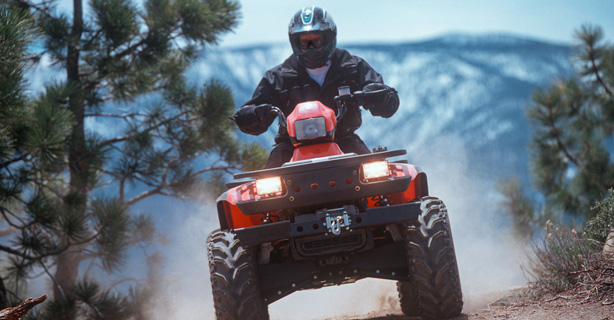
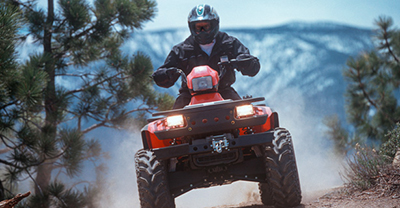
0 min. read
Riding an ATV is all about freedom and fun—but safety has to come first. In 2024, 632 off-highway vehicle (OHV) riders lost their lives—a 127% increase from the previous year, according to the Consumer Federation of America. Tragically, 119 of those deaths involved children under 16.*
And it’s not just fatal accidents—about 102,000 OHV riders visit the emergency room each year, reports the U.S. Consumer Product Safety Commission.*
Whether you’re new to trail riding or have years of experience, it’s worth taking a few minutes to review some simple safety steps. These 10 tips can help you stay safe—and enjoy the ride.

Get a free off-road insurance quote from Dairyland.
1. Start every ride with the right protective gear
Every ride should begin with ATV/UTV appropriate safety gear. At minimum, wear:
A DOT-approved helmet
Goggles or a full-face shield
Gloves
Over-the-ankle boots
Long sleeves and pants
Depending on the terrain, you might also want to add a chest protector, knee and elbow pads, or a neck brace for added protection.
2. Do a quick pre-ride inspection
Just like checking your car before a road trip, a simple walkaround can help you spot problems before they cut your ride short. Before you ride, check:
Tire pressure and condition
Brakes and throttle response
Lights and battery
Fuel and oil levels
Loose bolts or cables
Addressing small issues before you ride can help prevent breakdowns, avoid accidents, and keep your day on track.
3. Ride with care—know your limits and surroundings
Every ATV—and every rider—is built differently. Most machines are designed for just one rider. Unless yours is built to carry a passenger, ride solo to keep the vehicle balanced and help avoid tipping.
Just as important—pay attention to the terrain around you. Riding through sand, mud, rocks, or steep trails requires different speeds, techniques, and braking. Adjust your riding style to match the conditions—and give yourself space to react.
4. Take a safety course—even if you’ve been riding for years
Even experienced riders can benefit from formal safety training. Certified courses—like those from the ATV Safety Institute—reinforce smart habits and teach techniques that can help you handle challenging terrain or respond to emergencies. It’s more than a requirement in some states—it’s a practical way to stay sharp and ride with control.
5. Stick to designated trails and avoid public roads
Most public roads aren’t made for ATVs—and in many areas, riding on them is illegal. On-road drivers may not see you in time, and your ATV likely lacks required safety features for street travel. Stick to marked trails, and if your area requires permits or registration, make sure they’re up to date.

Request your free ATV insurance quote today.
6. Ride smart: Respect others and be ready for the unexpected
ATV trails are more than just dirt and scenery—they’re shared spaces. Ride respectfully by maintaining a safe distance from others, using hand signals or radios to communicate, and slowing down near hikers or other vehicles.
Also, pack a small emergency kit that includes basic first aid supplies, a trail map or GPS, a flashlight, water, and a charged phone or radio. If you're exploring remote areas, let someone know your plan before you go.
7. Know your machine’s limits—and your own
High-speed stunts and jumps might look exciting, but they can be dangerous without professional training. Avoid wheelies, ramps, and other tricks that go beyond your ATV’s intended design. Stick to what you’ve practiced—and keep all four wheels on the ground for safer rides.
8. Know your local laws
ATV regulations vary by state and county. Some areas require helmets, permits, or minimum rider ages. Others may ask for proof of insurance. Check with your local Department of Motor Vehicles (DMV) or Natural Resources Department for the most current rules before heading out.
9. Supervise younger riders and choose age-appropriate vehicles
ATVs come in different sizes for a reason. Children under 16 should stick to youth-model machines that match their size, strength, and skill level. Adult-sized ATVs are heavier, faster, and harder to control—especially for younger operators.
Make sure youth wear proper safety gear, ride with adult supervision, and stay on trails that match their experience. For added confidence, consider a safety course designed specifically for junior riders.
10. Never ride impaired
Operating an ATV under the influence of alcohol, drugs, or certain medications can slow your judgment and reaction time. Just like driving a car, staying sober behind the handlebars helps protect you and everyone around you.
ATV insurance that fits how you ride
Riding off-road comes with risk—and even with the best safe riding habits, unexpected events can still happen. Insurance can help protect your ride and your wallet, whether you're out on the trail or hauling your ATV home.
Dairyland®, a brand of the Sentry Insurance Group, offers flexible off-road coverage options. If you're looking for extra protection on your adventures, or are just curious about your options, we can help—contact us to learn more.

Get a free ATV insurance quote today.
The general information in this blog is for informational or entertainment purposes only. View our blog disclaimer.
*Data accuracy is subject to this article's publication date.








